This page covers the following models :
350GT and variants
400GT and variants
Islero
The 350GTV had a primarily race
engine,
with six downdraught carburettors and dry sump lubrication and produced 360bhp,
whilst the frame utilised tubing in a trellis-like construction. The body
was designed by Scaglione, then working for Carrozzeria Sargiotto in Turin
whilst Dallara designed the chassis and Bizzarrini the engine. A second
example was completed and used for testing the mechanical parts.
At the Paris Motorshow of 1965 there appeared
a 3500GTZ with a new body designed by Zagato, but only the two examples
were built. Another two examples were built of the 350GTS, a convertible
version produced by Touring and shown at the Turin Motorshow later in 1965.
A total of 131 350GT cars were built (not including the one-offs).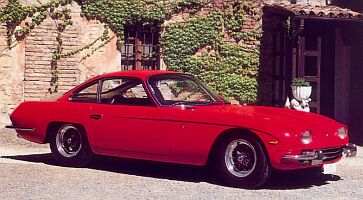 The
first production car made by Lamborghini, the 350GT, entered production
in May 1964 at the new Sant'Agata factory. It had been seen first as the
350GTV at the Geneva show in 1963, but had undergone many changes since
then.
The
first production car made by Lamborghini, the 350GT, entered production
in May 1964 at the new Sant'Agata factory. It had been seen first as the
350GTV at the Geneva show in 1963, but had undergone many changes since
then.
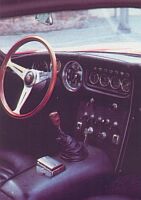 When
the production car appeared at the same show one year later, it had an
engine modified to be suitable for a GT road car, with wet sump lubrication, sidedraught
carburettors (to allow a lower bonnet line) and producing 270bhp. The frame
adopted square section tube and became much heavier (as well as being stretched
by 100mm) whilst the body was designed and built by Touring. The car was
a two seater, with a limited luggage space behind the seats. The body was
all aluminium and the interior was trimmed in a manner befitting an expensive,
luxurious car (unlike some of its rivals) including such novelties (at
that time) as electric windows.
When
the production car appeared at the same show one year later, it had an
engine modified to be suitable for a GT road car, with wet sump lubrication, sidedraught
carburettors (to allow a lower bonnet line) and producing 270bhp. The frame
adopted square section tube and became much heavier (as well as being stretched
by 100mm) whilst the body was designed and built by Touring. The car was
a two seater, with a limited luggage space behind the seats. The body was
all aluminium and the interior was trimmed in a manner befitting an expensive,
luxurious car (unlike some of its rivals) including such novelties (at
that time) as electric windows.
Technical Details
| Engine | 3464cc (77x62mm) 60deg V12 with dohc (per bank) and 270bhp @ 6,500rpm |
| Suspension | front : double wishbone and coil springs plus anti-roll bar
rear : double wishbone and coil springs plus anti-roll bar wheelbase : 2550mm track (front/rear) : 1380mm/1380mm |
| Brakes | Girling discs all round with servo assistance
mechanical handbrake operating on the rear wheels |
| Transmission | 5 speed manual (ZF unit) |
| Steering | worm and screw (by ZF) |
| Kerb weight | 1210kg |
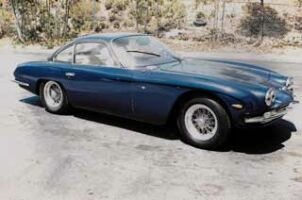 Developed
primarily to offer better accomodation (2+2 as opposed to 2) than the 350GT,
the 400GT 2+2 debuted at the Geneva Motorshow in March 1966. The new 4-litre
engine also became available in a modified (with the new style lights and grille
plus panels in steel) 350GT body, thus called the 400GT. The new 2+2 retained
the same style as the 350GT, but most of the panels were different. The wheelbase
was stretched slightly, the floor lowered and the roof raised, all in order
to provide enough room for the rear passengers. The rear suspension was
also modified in light of the new weight distribution. The body also moved
to a steel construction whilst the visually most noticeable change was
the adoption of twin round headlights instead of the large oval units of the 350GT.
Developed
primarily to offer better accomodation (2+2 as opposed to 2) than the 350GT,
the 400GT 2+2 debuted at the Geneva Motorshow in March 1966. The new 4-litre
engine also became available in a modified (with the new style lights and grille
plus panels in steel) 350GT body, thus called the 400GT. The new 2+2 retained
the same style as the 350GT, but most of the panels were different. The wheelbase
was stretched slightly, the floor lowered and the roof raised, all in order
to provide enough room for the rear passengers. The rear suspension was
also modified in light of the new weight distribution. The body also moved
to a steel construction whilst the visually most noticeable change was
the adoption of twin round headlights instead of the large oval units of the 350GT.
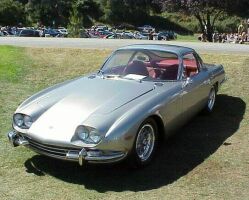 Limited
numbers were also made of the 400GTV which featured a 350bhp version of
the engine, having switched back to vertical downdraught carburettors,
the bonnet being raised to cover them. These cars also used the new Lamborghini developed gearbox.
Limited
numbers were also made of the 400GTV which featured a 350bhp version of
the engine, having switched back to vertical downdraught carburettors,
the bonnet being raised to cover them. These cars also used the new Lamborghini developed gearbox.
1966 also saw two one-offs emerge from
Touring. First came the 400GTS at Geneva, a convertible version of the
new car, followed by the 'Flying
Star II' at Turin, a 2+2 car with an all-new body design.
A total of 23 examples of the 400GT and
224 examples of the 400GT2+2 were built.
The 400GT2+2 would accelerate to 100km/h in 6.8 seconds, cover the standing km in 26.38 seconds
and arrive at a maximum speed of 260km/h. To stop from 100km/h needed 60 metres.
Technical Details
| Engine | 3929cc (82x62mm) 60deg V12 with dohc (per bank) and 320bhp @ 6,500rpm |
| Suspension | front : double wishbone and coil springs plus anti-roll bar
rear : double wishbone and coil springs plus anti-roll bar wheelbase : 2540mm track (front/rear) : 1380mm/1380mm |
| Brakes | Girling discs all round with servo assistance
mechanical handbrake operating on the rear wheels |
| Transmission | 5 speed manual |
| Steering | worm and screw (by ZF) |
| Kerb weight | 1249kg |
A total of 125 GTs and 100 GTSs were built until 1970.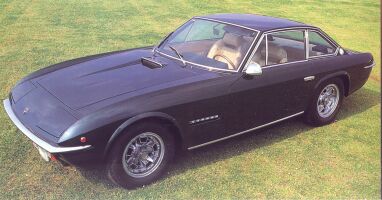 An
all new body with more angular lines fitted to an almost unmodified 400GT
chassis, the Islero was designed by Lamborghini and Marazzi together and
produced by Touring. The interior was also all new, and rather improved,
along with more space for the rear passengers. A version with a 350bhp
engine, the Islero S, was also built in small numbers.
An
all new body with more angular lines fitted to an almost unmodified 400GT
chassis, the Islero was designed by Lamborghini and Marazzi together and
produced by Touring. The interior was also all new, and rather improved,
along with more space for the rear passengers. A version with a 350bhp
engine, the Islero S, was also built in small numbers.
Technical Details
| Engine | 3929cc (82x62mm) 60deg V12 with dohc (per bank) and 320bhp @ 6,500rpm |
| Suspension | front : double wishbone and coil springs plus anti-roll bar
rear : double wishbone and coil springs plus anti-roll bar wheelbase : 2550mm track (front/rear) : 1380mm/1380mm |
| Brakes | Girling discs all round with servo assistance
mechanical handbrake operating on the rear wheels |
| Transmission | 5 speed manual |
| Steering | worm and screw (by ZF) |
| Kerb weight | 1315kg |
See our picture gallery index for images from museums, motorshows and events.
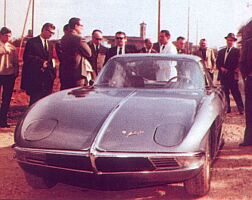 Return to the main Lamborghini page, use the buttons at the top to navigate further, or
LM002
Return to the main Lamborghini page, use the buttons at the top to navigate further, or
LM002